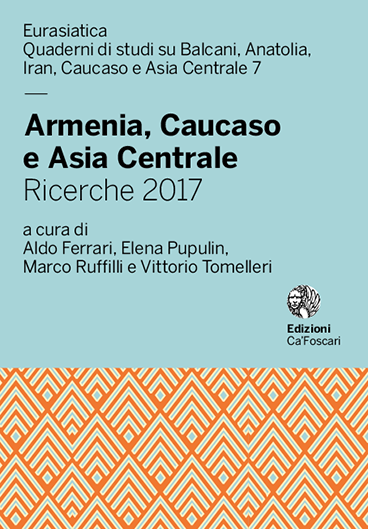Series |
Eurasian Studies
Volume 7 | Edited book | Armenia, Caucasus and Central Asia
Armenia, Caucasus and Central Asia
Research 2017
open access | peer reviewed-
edited by
- Aldo Ferrari - Università Ca’ Foscari Venezia, Italia - email orcid profile
- Elena Pupulin - Università Ca’ Foscari Venezia, Italia - email
- Marco Ruffilli - Université de Genève, Suisse - email
- Vittorio Springfield Tomelleri - Università degli Studi di Torino, Italia - email
Abstract
This new volume in the series Eurasiatica. Quaderni di Studi su Balcani, Anatolia, Iran, Caucasus and Central Asia by Edizioni Ca' Foscari of Venice collects several articles devoted to Armenia, Caucasus and Central Asia. The articles in the volume range from archaeology to literature, from folklore to history, from the history of Eastern Christianity to art, from travel narratives to urban planning. An entire section is devoted to Ossetian studies, which are of great interest not only in the Caucasian and Iranian spheres, but also in Russian history and culture.
Keywords Carla Serena • Nart epos • Migration • Ossetian folklore • The Ossetians of Turkey • Pastoralism • Anna Akhmatova • Icons, Incarnation of Christ, Prince Ašot II Bagra • End of the XIX century-beginning of the XX century • Lexical unit • Nomadism • Motivation • Oral story • Caucasus • Translation unit • Ethnoarchaeology • Biographies • Conversion • Early photographs • Stylistic means • Fortress • Artistic image • Artistic translation • Diplomacy • Transcription • Urartu • Equivalence • Central Asia • Substring • Translated text • Translating language • Travel writing • Abkhazia • Early modern times • Georgia • Ossetia • Religious buildings • Formation of urban space • Chetagurov • Ossetic folklore • National colouring • Confessional groups • Archaeology • Kosta Khetagurov • National diasporas • Equivalency • Iron Age • Monastic practices • Tbilisi • Armenia • Manuscript tradition • Či dæ? (Kto ty?) • Non-fairy prose • Caucaso • Akhmatova • Palestine • Source text • Anthology • Murghab • Turkmenistan • Venice • Gaza • Source language • Travels • The city of Vladikavkaz • Baku • Ossetic literature • Azerbaijan • Translation • Translations
Permalink http://doi.org/10.30687/978-88-6969-211-6 | e-ISBN 978-88-6969-211-6 | ISBN (PRINT) 978-88-6969-219-2 | Published Feb. 19, 2018 | Language ru, it
Copyright © 2018 Aldo Ferrari, Elena Pupulin, Marco Ruffilli, Vittorio Springfield Tomelleri. This is an open-access work distributed under the terms of the Creative Commons Attribution License (CC BY). The use, distribution or reproduction is permitted, provided that the original author(s) and the copyright owner(s) are credited and that the original publication is cited, in accordance with accepted academic practice. The license allows for commercial use. No use, distribution or reproduction is permitted which does not comply with these terms.
Prefazione
- Prefazione
- Feb. 19, 2018
Studi armeni, caucasici e centro-asiatici
-
La prima urbanizzazione in Turkmenistan: coesistenza tra nomadi e sedentari nel delta interno del fiume Murghab
Risultati preliminari delle indagini archeologiche ed etnografiche presso il sito di Togolok 1 - Feb. 19, 2018
- L’attività archeologica italiana dell’ISMEO in Armenia
- Feb. 19, 2018
-
La Vita siriaca di Pietro l’Ibero e la Vita greca di Melania la giovane
Due testi a confronto - Feb. 19, 2018
- L’icona miracolosa del principe Ašot II Bagratuni
- Feb. 19, 2018
-
Scoprendo le due fedi del re
Un contributo allo studio della visione dei Georgiani in documenti creati nell’ambiente diplomatico veneziano (1573–1645) - Feb. 19, 2018
-
Tra immagini e memorie
Scoprendo l’Abcasia con gli occhi di Carla Serena - Feb. 19, 2018
-
Trasformazioni architettoniche e urbane nello spazio post-sovietico
Il caso di Tbilisi e Baku - Feb. 19, 2018
Studi osseti
- Мотивационная основа устных рассказов осетин Турции
- Feb. 19, 2018
- Переводы Анны Ахматовой из осетинской поэзии
- Feb. 19, 2018
-
Anna Achmatova e Kosta Chetagurov
La genesi del testo poetico - Feb. 19, 2018
- Kosta Levanovič Chetagurov
- Feb. 19, 2018
